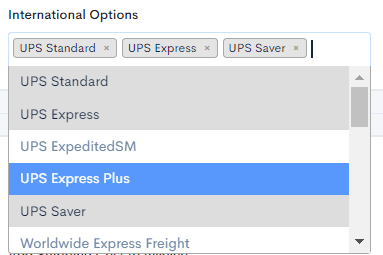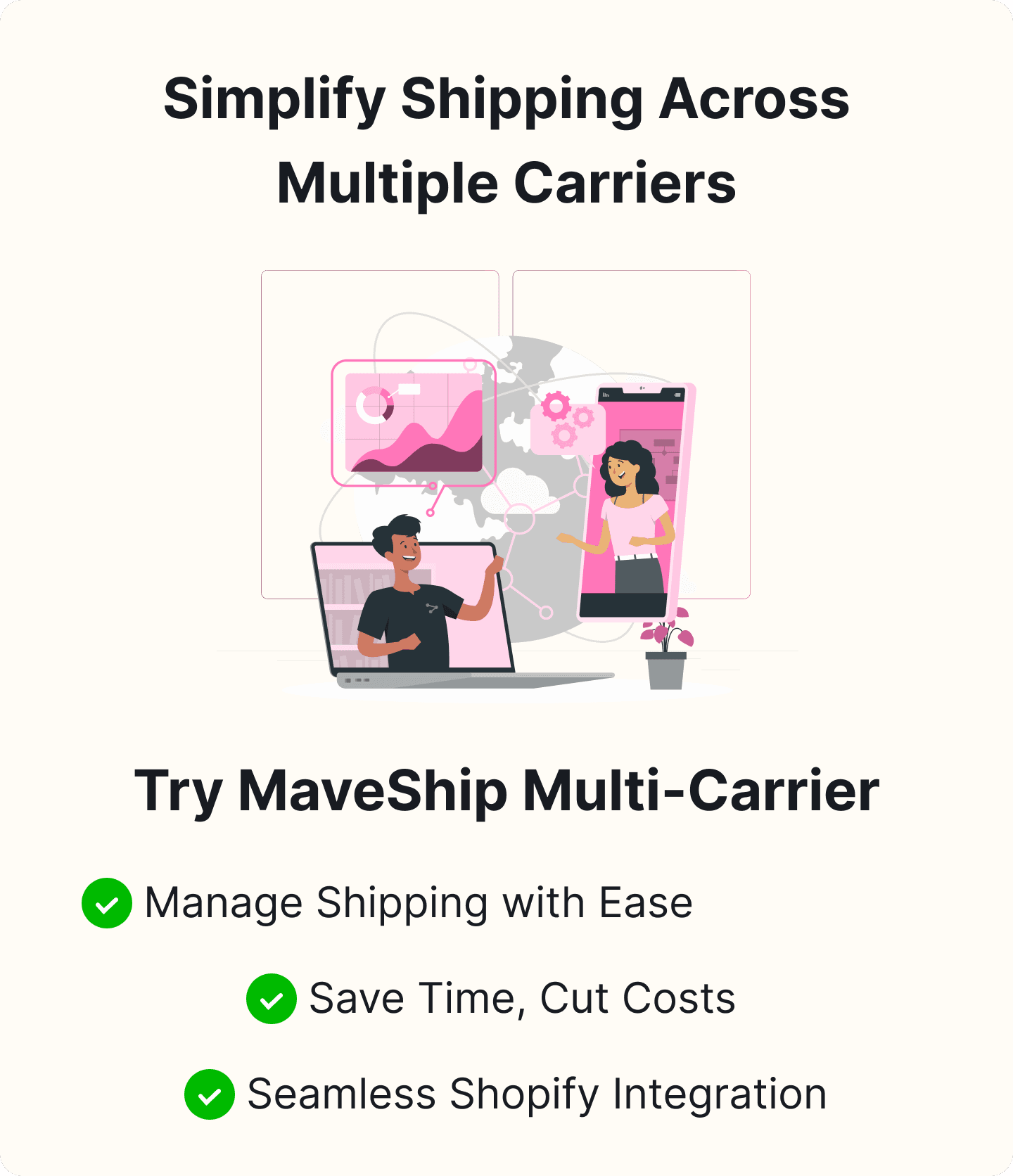How to Set Up UPS Shipping on Shopify?
Table of Content

Are you looking to streamline your shipping process on Shopify? This blog aims to teach you all you need to know about using UPS for shipping on your Shopify store, from setting up UPS as a shipping option to optimizing your overall shipping strategy.
Shipping is a crucial aspect of your e-commerce business, significantly impacting customer satisfaction and your bottom line. By integrating UPS with Shopify, you can offer reliable shipping options and provide real-time shipping rates to your customers, all streamlined with Appracadabra’s seamless solutions.
Shopify UPS Shipping
Setting up efficient and reliable shipping options is crucial for an online store, and Shopify offers a seamless integration with UPS to help you achieve just that. By using a multi-carrier shipping label app for Shopify, you can streamline your shipping process and ensure that your customers receive their orders promptly. UPS, a global logistics and package delivery leader, works seamlessly with this app, enhancing your store's reputation and boosting customer satisfaction.
Why Choose UPS for Shopify Shipping?
UPS is known for its extensive network and advanced shipping solutions, making it a preferred choice for many e-commerce businesses. By integrating UPS with your Shopify store, you gain access to:

- Reliable Delivery Services:
UPS offers a range of shipping options, from same-day delivery to standard ground shipping, ensuring you can meet your customers' needs regardless of store location.
- Real-Time Tracking:
Both the customers and you can track orders in real-time, providing transparency and peace of mind.
- Competitive Rates:
Shopify's partnership with UPS lets you take advantage of the discounted shipping rates to save on costs while offering competitive shipping prices to your customers.
- Global Reach:
With UPS, you can ship to more than 220 countries and territories, making it easier to expand your business internationally.
- Efficient Returns Management:
Simplify your return process with UPS's robust returns management solutions, ensuring a hassle-free experience for your customers.
Streamlined Integration with Shopify
Shopify makes it easy to integrate UPS shipping into your store with just a few steps. Once set up, you can manage all your shipping needs directly from your Shopify dashboard, streamlining your operations and saving you time. The integration also allows you to:
- Automate Shipping Calculations:
Display accurate shipping rates at checkout so your customers know what to expect.
- Print Shipping Labels:
Generate and print UPS shipping label app directly from your Shopify admin, reducing manual tasks and speeding up order fulfillment.
- Schedule Pickups:
Arrange for UPS to pick up your packages, saving you trips to the post office and allowing you to focus more on growing your business.
By setting up UPS shipping on Shopify, you're not just choosing a delivery service; you're opting for a comprehensive shipping solution that supports your business's growth and ensures customer satisfaction. In the following sections, we'll guide you through the step-by-step process of integrating UPS with your Shopify store so you can start shipping smarter and faster.
Setting up UPS Integration on Shopify
Setting up UPS shipping on your Shopify store ensures efficient order fulfillment and provides your customers with reliable shipping options. Follow these steps to integrate UPS with your Shopify store seamlessly.
Understanding the UPS Shopify App
The UPS Shopify app is a powerful tool that connects your Shopify store to UPS's shipping services. You can access real-time shipping rates, generate the shipping labels, track your shipments from your Shopify dashboard. This integration streamlines your shipping process, saving time and reducing errors. Here's what you need to know about the UPS Shopify app:
- Real-Time Shipping Rates:
Provide your customers with accurate shipping rates at checkout.
- Label Generation:
Create and print shipping labels for your orders effortlessly.
- Tracking:
Keep track of your shipments and provide customers with UPS tracking information.
- Flexibility:
Customize shipping options to meet the needs of your business and customers.
Adding Your UPS Account to Shopify
To utilize UPS services on your Shopify store, you'll need to link your UPS account with Shopify. Follow these steps to set up the integration:
Step-by-Step Guide for UPS and Shopify Integration

- Sign Up or Log In to Your UPS Account:
If you don't already have a UPS account, visit the UPS website and sign up. If you have a UPS account number, log in with your credentials.
- Navigate to Shopify Admin:
Log in to the Shopify admin panel and go to Settings.
- Select Shipping and Delivery:
From 'Settings,' click on 'Shipping and Delivery' to access the shipping settings page.
- Manage Carriers and Rates:
Under 'Shipping carriers,' click on 'Manage carriers and rates.'
- Add UPS as a Carrier:
Click 'Add Carrier' and select 'UPS' from the list of available carriers.
- Connect Your UPS Account:
Follow the prompts to connect your account to Shopify. You'll need to enter your UPS account details, such as your account number and API key, which you can obtain from your UPS account dashboard.
- Configure Shipping Settings:
After connecting your UPS account, configure the shipping settings according to your preferences. This includes setting up shipping zones, rates, and services like signature confirmation or insurance.
- Save Your Settings:
Once you've configured everything, click 'Save' to finalize the integration.
Understanding Shopify UPS Shipping Rates
Setting up UPS shipping on your Shopify store can significantly streamline your logistics, ensuring your customers receive their Shopify orders promptly and cost-effectively.

Overview of UPS Shipping Rates


UPS offers a variety of shipping rates that cater to different business needs. These rates are influenced by factors such as the dimensions and weight of the package, the shipping destination, and the chosen shipping service (e.g., UPS Ground, UPS 2nd Day Air, UPS Next Day Air). Shopify integrates seamlessly with UPS to provide real-time shipping rates at checkout, allowing customers to see accurate shipping costs based on their order specifics.
Calculating Shipping Costs for Different Products
To accurately calculate shipping costs, consider the characteristics of your products and how they impact the shipping rate calculation. Here's a breakdown of the critical factors:
Key Factors:

- Weight-based Shipping Rates:
Calculated based on the actual weight of the package. UPS charges incrementally, meaning the heavier the package, the higher the shipping cost.
- Dimension-based Shipping Rates:
Consider the package size, not just the weight. This is crucial for bulky or irregularly shaped items. UPS calculates dimensional weight using the formula: (Length x Width x Height) / Dimensional Factor.
- Service-Specific Rates:
Rates vary depending on the speed and type of UPS service selected, such as standard ground delivery or expedited air services.

By understanding and implementing these shipping rate calculations, you can offer your customers fair and accurate shipping costs, enhancing their shopping experience while maintaining profit margins.
Scheduling UPS Pickup on Shopify
Scheduling UPS pickup directly through Shopify can significantly streamline your order fulfillment process. By integrating UPS pickup, you can ensure that your packages are collected directly from your location, reducing the time and effort needed to transport them to a drop-off point. This integration helps you maintain efficient operations, minimizes delays, and enhances customer satisfaction by ensuring timely deliveries.
Step-by-Step Guide for Scheduling UPS Pickup
1. Automating Pickup Requests

- Navigate to Shipping Settings:
Go to your Shopify admin and click 'Settings,' then 'Shipping and Delivery.'
- Select UPS Carrier:
Choose UPS as your shipping carrier and enter your UPS account details if you haven't already.
- Enable Pickup Requests:
In the UPS settings, enable the option to schedule pickups.
- Set Pickup Preferences:
Specify your preferred pickup times and locations. You can choose daily pickups or schedule them as needed.
- Save Settings:
Save your settings to automate the pickup requests for all your future shipments.
2. Efficient Order Fulfillment through UPS Pickup

- Prepare Shipments in Advance:
Make sure all your orders are packed and ready for pickup before the scheduled time.
- Label Packages Properly:
Ensure all packages have the correct shipping labels and documentation.
- Communicate with UPS:
Maintain clear communication with your UPS representative to handle any special requests or changes in pickup schedules.
- Monitor Pickup Status:
Use the Shopify dashboard to monitor the status of your scheduled pickups and ensure they are completed as planned.
Managing UPS Claims on Shopify
Understanding the UPS claim process is crucial for resolving shipping issues efficiently. Whether it's lost packages, damaged goods, or shipping discrepancies, knowing how to file and manage claims can save time and money. UPS provides a structured claim process to help merchants recover costs associated with shipping problems. Here's how:
Resolving Shipping Issues and Damaged Goods

- Document the Issue:
Take photos of damaged goods and keep all related documentation, including UPS labels and receipts.
- Initiate a Claim:
Go to the UPS website and log in to your account. Navigate to the claims section and start a new claim.
- Fill Out the Claim Form:
Provide all necessary details, including the tracking number, description of the issue, and supporting documentation.
- Submit your Claim:
Submit the claim form and await UPS's confirmation email.
- Follow-up:
Monitor the claim status on the UPS website and follow up if needed.
Successful Resolution of Shipping Discrepancies

- Identify the Discrepancy:
Check for any inconsistencies in shipment details, such as weight, dimensions, or delivery address.
- Gather Evidence:
Collect the relevant information and documentation that supports your claim.
- Contact UPS Support:
Reach out to UPS customer support for assistance in resolving the discrepancy.
- Submit Necessary Documents:
Provide UPS with all the required documents and information to support your claim.
- Track the Claim:
Keep track of your claim's progress and promptly address all issues.
Using the UPS App for Shopify
The UPS app for Shopify offers a range of features that can enhance your order management process. By leveraging these features, you can streamline shipping operations, track shipments in real time, and provide your customers with timely updates.
Tracking and Notifications for Seamless Customer Experience
The UPS app lets you provide real-time shipment tracking details to your customers.
- Monitor Shipments:
Track the progress of all your shipments from your Shopify dashboard.
- Update Customers:
Automatically send tracking information to your customers, informing them about their order status.
- Automated Delivery Notifications:
Notify customers when their order is shipped, out for delivery, and delivered, reducing customer inquiries about order status.
Maximizing UPS Discounts on Shopify
Accessing exclusive UPS shipping discounts or free shipping can help you save significantly on shipping costs. Shopify merchants can benefit from negotiated rates that are lower than standard shipping rates, making it more affordable to ship products to customers.
Strategies for Cost-Effective Shipping Solutions
To negotiate better shipping rates:
- Analyze Shipping Volume:
Review your shipping volume and identify patterns or trends.
- Contact UPS:
Reach out to your UPS account representative to discuss your shipping needs and negotiate better rates based on your volume.
- Compare Rates:
Compare the negotiated rates with other carriers to ensure you get the best deal.
To take advantage of bulk shipping discounts:
- Consolidate Shipments:
Combine multiple orders into a consolidated shipment whenever possible to qualify for bulk discounts.
- Schedule Regular Pickups:
Set up regular pickups to ensure consistent shipping volumes, which can help negotiate better rates.
Optimize your UPS shipping to achieve cost savings by:
- Using Efficient Packaging:
Choose the right packaging to minimize dimensional weight charges.
- Leveraging UPS Tools:
Use UPS tools and software to find the most cost-effective shipping options.
- Monitoring Shipping Costs:
Regularly review your shipping expenses and adjust your strategies to maintain cost-effectiveness.
Following these guidelines, you can effectively add UPS shipping on Shopify, ensuring a smooth and efficient process that benefits your business and customers.
Conclusion
Integrating UPS shipping with your Shopify store can significantly enhance your e-commerce operations. The steps in this guide can help you streamline your shipping process, provide real-time shipping rates, and offer reliable delivery options to your customers. The seamless integration allows you to manage all your shipping needs from a single dashboard, reducing manual tasks and increasing efficiency.
UPS's robust shipping solutions and Shopify's user-friendly platform ensure that your orders are delivered promptly and securely, boosting customer satisfaction and trust in the brand. Offering competitive shipping rates and tracking shipments in real time further enhances the shopping experience, setting your store apart in a competitive market with the support of Appracadabra seamless integration.
Whether you're just starting or looking to optimize your shipping methods, leveraging UPS with Shopify can drive growth and improve your bottom line. By integrating a multi-carrier shipping label app for Shopify, you can automate shipping calculations, manage returns efficiently, and offer international shipping with UPS. This integration ensures you meet and exceed customer expectations while streamlining your operations. Embrace these tools and strategies to enhance your Shopify store's shipping operations and provide a superior shopping experience.

Thilak
Thilak is the Co-founder & COO at Appracadabra, helping businesses streamline their Shopify app management. His expertise in eCommerce and product development enables him to craft innovative tools that simplify operations and drive growth for online merchants.
